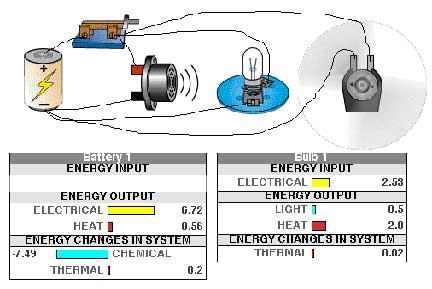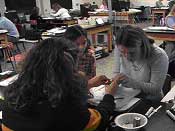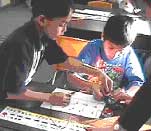Forum on
Education of The American Physical Society
Summer 2005 Newsletter
Physics for Elementary Teachers: A New Curriculum Steve Robinson, Fred Goldberg and Valerie Otero In accordance with the No Child Left Behind (NCLB) act of 2002a, it will soon be required that all elementary students are assessed in science content by the end of their fifth grade year. It is recognized that few elementary teachers are prepared for this, especially in the physical sciences[i]. Realizing this, many teacher preparation programs are replacing traditional science requirements for pre-service elementary teachers (usually a two semester sequence in any single lab science) with a cluster of one-semester content courses, including one in physics or physical science. Thus university physics departments are increasingly being called upon to implement a course exclusively for this audience. This can be quite a challenge since this is not the audience to which physics courses are traditionally targeted and it is desirable that such a course model the inquiry-based pedagogy that elementary teachers are expected to use in their own classrooms. Further, physics faculty may be unfamiliar with these inquiry-based methods of teaching. The Physics for Elementary Teachers (PET) curriculumb has been designed to address this challenge. It can be taught as a one-semester (75 hour) university course for prospective elementary teachers, or adapted for use as a workshop for practicing teachers. The course uses a learner-oriented, guided inquiry-basedpedagogy that helps prospective and practicing teachers develop a deep understanding of physics ideas that are closely aligned with those they will be expected to teach in their own classrooms. A unique aspect of the course is that it also contains embedded components that allow students to examine important aspects of the effective learning of science in three contexts; that of their own learning, the learning of elementary students, and the processes by which scientists develop knowledge. The development of the PET curriculum was guided by current research on how students learn most effectively. For each learning goal, PET provides a sequence of activities designed to elicit and build on students’ prior knowledge, to provide opportunities for them to test their initial ideas, and to guide them towards the development of ideas that are closely aligned with the ideas of scientists. In the PET classroom, students spend most of their time working in small groups, performing experiments, manipulating computer simulations, making sense of their observations, and then sharing ideas in whole class discussions. The instructor’s role is to guide whole class discussions, to help set classroom norms that support the development of ideas based on evidence, and to promote participation by all students. The physics learning goals for the PET course were selected from the middle school level of the National Science Education Standards[ii] and the AAAS Benchmarks for Scientific Literacy[iii], with a special emphasis on those with strong connections to the elementary level. Overarching themes of interactions, energy, and forces were chosen to give the curriculum an integrated, coherent, structure. The curriculum also addresses, both implicitly and explicitly, benchmarks and standards associated with the nature of science. In addition, the learner-centered pedagogical structure of the curriculum aligns well with national standards for teacher professional development. The
PET curriculum is centered on the theme of interactions between objects/systems. PET
students describe each observed interaction in terms of energy changes and transfers. They
also use “energy diagrams,” which are graphic representations of their descriptions
(Figure 1). The complexity of these descriptions is scaffolded throughout the entire
curriculum, starting with simple changes in kinetic energy in interactions between rigid
bodies, and ending with more complex situations in which there are chains of interactions
happening in parallel, with several different types of energy changes and transfers
occurring simultaneously. The construction of verbal and written explanations is also
scaffolded through the curriculum. Initially PET students are given substantial guidance
for this, in the form of model explanations, guiding questions, and practice in critiquing
others’ explanations. This support is gradually faded until finally they are simply
presented with a phenomenon to be explained with little or no guidance.
A part of the curriculum is devoted to helping students develop ideas equivalent to Newton’s 1st and 2nd Laws, describing the effect of interactions on the motion of an object in terms of the external forces exerted on it. It is well known that many students have ideas that mix together the scientific concepts of force and energy, and so the PET curriculum pays particular attention to helping students differentiate these ideas, yet still see the close connection between them. The idea of a ‘field of influence’ is introduced to explain action-at-a-distance forces, but is also used in the energy description of such interactions, in which the field itself becomes a source or receiver of energy. The first six cycles of activities in PET address physics content learning goals in the areas of mechanical interactions, force and motion, gravity, magnetism, electric circuits and electromagnetism, light and heat. The final short cycle revisits many of the interactions examined earlier in the course and starts by developing ideas of transient and equilibrium states in a system. The cycle concludes with students developing a quantitative description of energy conservation by using a special tool in the computer simulators (Figure 2). Each cycle consists of a set of activities in which students are guided to develop their own ideas by trying to explain the outcomes of experiments, and by coming to consensus as a class. At the end of the idea development process students are given a ‘Scientists’ Ideas’ sheet to confirm to them that the ideas they have developed are closely aligned with those of the scientific community. The final activity in each cycle allows students to practice applying their newly developed ideas to explain both familiar and new phenomena. The curriculum makes extensive use of embedded homework assignments to help students develop, and practice using, their ideas. These homework assignments often involve using web-based computer simulators, or watching short movies of simple experiments, provided on a ‘Student Resources’ CD.
Embedded throughout the course are activities and homework assignments that explicitly address the curriculum goals for ‘learning about learning.’ Most of these activities involve PET students analyzing short video segments of elementary students as they work through physics activities that are similar in nature to activities contained within the PET curriculum. Such activities are included in PET to serve two purposes. First, by evaluating the learning of other students, PET students have the opportunity to gain an in-depth understanding of their own learning process. Second, as prospective and practicing elementary teachers, the activities give PET students the chance to apply their physics knowledge in the relevant context of their chosen profession (Figure 3). Other activities prompt students to reflect on what elements of the PET classroom and course structure have facilitated their own learning. Finally, one entire cycle of the PET course (in which students are guided to construct a domain model of magnetism), provides the context for an activity that explicitly examines the ‘nature of science’; that is, the processes by which science knowledge is generated, and the nature of that knowledge itself.
So far, the PET curriculum has been field tested at over twenty two-year and four-year institutions, has been adapted for a science methods course in schools of education, and has been offered as a workshop for practicing elementary teachers. (For the latter version, special activities have been included that teachers can use in their own elementary classrooms.) Preliminary data from pre/post diagnostic testing has shown significant improvement in student understanding of the physics target ideas, as well as a greater appreciation for the value of the guided inquiry-based pedagogy modeled by the course. To support faculty who wish to implement the PET course an extensive web-based Teacher Guide has been developed, together with a framework for a professional development workshop. The developers are also offering workshops and tutorials at national meetings of the AAPT (including upcoming meetings at Salt Lake City and Anchorage). For more information on the PET curriculum and further opportunities to learn about it please visit the web page at cpucips.sdsu.edu/web/pet. References: a Public Law 107-110-2002. b The development and field-testing of the PET curriculum has been supported by National Science Foundation grant 0096856. [i] Stodolsky, S., & Grossman, P. (2000). Changing students, changing teaching. Teachers College Record (102), 125-172. [ii] National Research Council (1995). National Science Education Standards (NSES). Washington DC: National Academy Press. [iii]
American Association for the Advancement of Science (AAAS)
(1993). Benchmarks for science literacy. New York: Oxford University Press. Steve Robinson is Chair of the Physics Department at Tennessee Technological University. Fred Goldberg is member of both the Department of Physics and the Center for Research in Math and Science Education at San Diego State University. Valerie Otero is a member of the School of Education at the University of Colorado at Boulder. All three have research interests in the field of physics education, including how the use of technology can enhance hands-on experiences in student learning, how the learning environment influences student development of ideas, and the role of students’ prior knowledge in their learning. |




